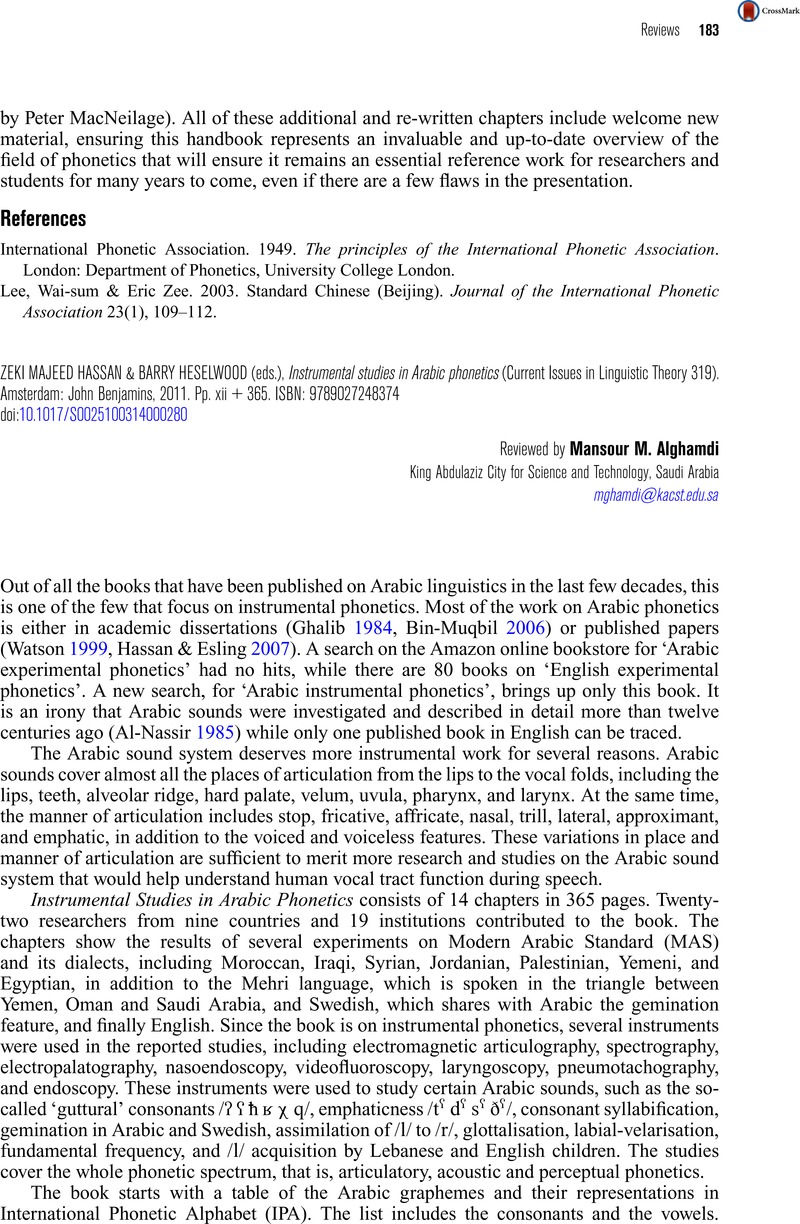No CrossRef data available.
Article contents
ZEKI MAJEED HASSAN & BARRY HESELWOOD (eds.), Instrumental studies in Arabic phonetics (Current Issues in Linguistic Theory 319). Amsterdam: John Benjamins, 2011. Pp. xii + 365. ISBN: 9789027248374
Review products
ZEKI MAJEED HASSAN & BARRY HESELWOOD (eds.), Instrumental studies in Arabic phonetics (Current Issues in Linguistic Theory 319). Amsterdam: John Benjamins, 2011. Pp. xii + 365. ISBN: 9789027248374
Published online by Cambridge University Press: 20 July 2015
Abstract
An abstract is not available for this content so a preview has been provided. Please use the Get access link above for information on how to access this content.

- Type
- Book Review
- Information
- Journal of the International Phonetic Association , Volume 45 , Issue 2 , August 2015 , pp. 183 - 185
- Copyright
- Copyright © International Phonetic Association 2015
References
Alghamdi, Mansour. 2004. Analysis, synthesis and perception of voicing in Arabic. Riyadh: Al-Toubah Bookshop.Google Scholar
Al-Nassir, A. A.
1985. Sibawayh the phonologist: A critical study of the phonetic and phonological theory of Sibawayh as presented in his treatise on Al-Kitab. Ph.D. thesis, The University of York.Google Scholar
Bin-Muqbil, Musaed S.
2006. Phonetic and phonological aspects of Arabic emphatics and gutturals. Ph.D. dissertation, University of Wisconsin–Madison.Google Scholar
Brücke, Ernst von. 1860. Beitrage zur Lautlehre der arabischen Sprache. Wiener Sitzungsberichte Philologisch-historische Classe 34, 307–356.Google Scholar
Flege, J.
1979. Phonetic interference in second language acquisition. Ph.D. dissertation, Indiana University.Google Scholar
Ghalib, Ghalib Baqir Mohammed. 1984. An experimental study of consonant gemination in Iraqi colloquial Arabic. Ph.D. thesis, University of Leeds.Google Scholar
Hassan, Zeki Majeed & Esling, John H.. 2007. Laryngoscopic (articulatory) and acoustic evidence of a prevailing emphatic feature over the word in Arabic. 16th International Congress of Phonetic Sciences (ICPhS XVI), Saarbrücken, 153–158.Google Scholar
Potter, Ralph K., Kopp, George A. & Green, Harrier. 1947. Visible speech. New York: Van Nostrand.Google Scholar
Raphael, Lawrence J. 1971. Preceding vowel duration as a cue to the perception of the voicing characteristic of word-final consonants in American English. Journal of the Acoustical Society of America
51, 1296–1303.CrossRefGoogle Scholar
Vollers, Karl. 1892. The system of Arabic sounds. In Morgan, Edward Delma (ed.), The Ninth International Congress of Orientalists, London, vol. II, 130–154.Google Scholar
Watson, Janet C. E.
1999. The directionality of emphasis spread in Arabic. Linguistic Inquiry
30.2, 289–300.CrossRefGoogle Scholar


